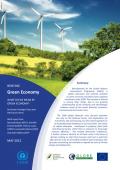This plan, produced by Climate Works Australia, sets out emissions reductions opportunities for Australia, the challenges faced in capturing them, and actions required to succeed. The report identifies opportunities available to businesses as well as guiding the actions required for Government and consumers to achieve the emissions reductions for Australia at the lowest possible cost. The report is not a national strategy of the Australian Government per se, but it was funded through the Australian Carbon Trust and regional and national governmental departments.

The ‘Building a Low‐Carbon Indian Economy’ report, by the Confederation of Indian Industry, recognises that although India is undergoing a phase of rapid industrial development there are clear signs that ‘industry in India has adopted an approach that can help India leapfrog to a low‐carbon economy’. The report asserts that this can be done by adopting suitable policies to promote non‐carbon intensive fuels, renewables and state‐of‐the‐art technologies to promote energy efficiency.
The strategy identifies 12 priority areas with the potential to mitigate India’s carbon emissions and put the country on the path to a low‐carbon economy. These are: Renewable Energy, Energy Efficiency, Cleaner Conventional Energy Technologies, Hydrogen Fuel Cells, Free and Open Markets, Green Buildings, The Aviation Sector, Water Efficiency, Agriculture, Afforestation, Research & Development and Financing.
The document concludes by providing specific actions to be undertaken by government, industry and civil society independently, that will put India on a path to a low‐carbon economy.

Reinvigorated by the United Nations Environment Programme (UNEP), a global discussion and national activities on green economy transitions have regained momentum since 2008. The increase in interest is, among other things, due to the growing understanding of the similarity and interlinkages between many of the recent financial, economic, environmental and social crises.
The 2008 global financial crisis focused attention not only on the financial losses, and implications for economies, jobs and housing, but also raised questions as to the fundamental imbalance in our economies. The choice of capital allocation - investment in property, fossil fuels and financial assets, rather than in measures to encourage resource efficiency - has created destructive imbalances. A further common element to all these crises is the focus of decision making on short time horizons and trust in what has often proven to be an incomplete evidence base including a lack of proper accounting, for example as regards the cost of climate change and biodiversity.
One of the strong messages that came out of the United Nations Climate Change conference in Durban was that the private sector has to play an important role if we are to globally move toward a low carbon, climate resilient—or “climate compatible”—future. However, private investment will only flow at the scale and pace necessary if it is supported by clear, credible, and long-term policy frameworks that shift the risk-reward balance in favor of less carbon-intensive investment. The private sector also needs information on where to invest in clean energy in emerging markets, and it needs policy support to lower investment risk. Barriers to low carbon investments often include unclear and inconsistent energy policies, monopoly structures for existing producers, stronger incentives for conventional energy than clean energy, and a domestic financial sector not experienced in new technologies.
This report is very much focused on private sector led initiatives to responding to climate change. The report is based upon the results of a survey of business leaders committed to advancing climate action, especially in ways that build the resilience of vulnerable communities in developing countries. It offers help to companies with national, regional or global reach to develop strategies for dealing with the immediate to long‐term consequences of climate change in developing countries where they have operations, supply chains, employees, or customers.
